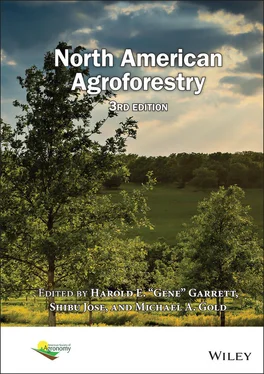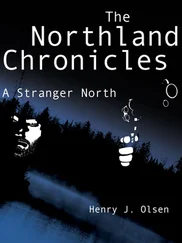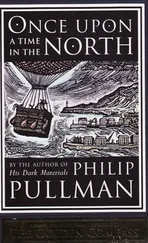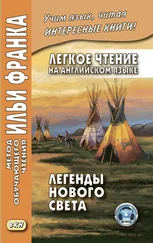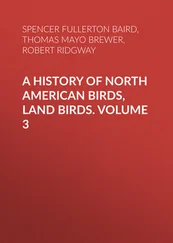North American Agroforestry
Здесь есть возможность читать онлайн «North American Agroforestry» — ознакомительный отрывок электронной книги совершенно бесплатно, а после прочтения отрывка купить полную версию. В некоторых случаях можно слушать аудио, скачать через торрент в формате fb2 и присутствует краткое содержание. Жанр: unrecognised, на английском языке. Описание произведения, (предисловие) а так же отзывы посетителей доступны на портале библиотеки ЛибКат.
- Название:North American Agroforestry
- Автор:
- Жанр:
- Год:неизвестен
- ISBN:нет данных
- Рейтинг книги:4 / 5. Голосов: 1
-
Избранное:Добавить в избранное
- Отзывы:
-
Ваша оценка:
- 80
- 1
- 2
- 3
- 4
- 5
North American Agroforestry: краткое содержание, описание и аннотация
Предлагаем к чтению аннотацию, описание, краткое содержание или предисловие (зависит от того, что написал сам автор книги «North American Agroforestry»). Если вы не нашли необходимую информацию о книге — напишите в комментариях, мы постараемся отыскать её.
Explore the many benefits of alternative land-use systems with this incisive resource North American Agroforestry
North American Agroforestry
North American Agroforestry — читать онлайн ознакомительный отрывок
Ниже представлен текст книги, разбитый по страницам. Система сохранения места последней прочитанной страницы, позволяет с удобством читать онлайн бесплатно книгу «North American Agroforestry», без необходимости каждый раз заново искать на чём Вы остановились. Поставьте закладку, и сможете в любой момент перейти на страницу, на которой закончили чтение.
Интервал:
Закладка:
Table of Contents
1 Cover
2 Series Page
3 Title Page
4 Copyright Page
5 Preface
6 Acknowledgments
7 Section I: Agroforestry Fundamentals 1 Agroforestry as an Integrated, Multifunctional Land Use Management Strategy Land use Management Systems in North America Opportunities for Agroforestry Progress to Date and Challenges Ahead Future Needs References Study Questions 2 Agroforestry Nomenclature, Concepts and Practices Native American Agroforestry Agroforestry as a Science Definition and Practices Is it Agroforestry? Agroforestry Concepts References Study Questions 3 An Agroecological Foundation for Temperate Agroforestry Ecological Interactions in Mixed Tree and Herb Systems General Ecological Principles Indicators of Agroecosystem Sustainability Ecological Goods and Services Conclusions Acknowledgments References Appendix 3‐1 4 Tree–Crop Interactions in Temperate Agroforestry Species Coexistence and Ecological Interactions Competitive Interactions—Aboveground Facilitative Interactions—Aboveground Competitive Interactions—Belowground Facilitative Interactions—Belowground The Future Conclusion References Study Questions
8 Section II: Agroforestry Practices 5 Windbreak Practices How Windbreaks Work Windbreaks in Agricultural Production Systems Windbreak Technology at the Farm and Landscape Levels Summary References Study Questions 6 Silvopasture Practices Livestock and Tree Integration in North America Silvopasture Concepts Integrating Silvopastoral Components Silvopastoral Regions The Future of Silvopastoral Systems References Study Questions 7 Alley Cropping Practices History of Alley Cropping Tree Component Crop Component Economics of Alley Cropping Ecological Benefits Potential for Alley Cropping in the United States Conclusions References Study Questions 8 Riparian and Upland Buffer Practices Hillslope and Channel Processes in Agricultural Landscapes The Hydrologic Cycle: Paths within an Ecosystem Functions of Riparian Buffers Restoration of Riparian Zone Functions Stream Bank Bioengineering as Part of the Riparian Buffer Practice Constructed Wetlands to Mitigate Subsurface Drainage Tile Flow Riparian Grazing Practices Final Thoughts on Riparian Forest and Upland Buffers References Study Questions 9 Forest Farming Practices What is Forest Farming? What are Nontimber Forest Products? Who Might Forest Farm NTFPS? Establishing a Forest Farm Market Perspective for Forest Farmed Products Forest Farming Culinary Products Forest Farming Medicinal Products Forest Farming Floral and Landscaping Products Trees and Related Products Integral to Forest Farming Marketing Forest Farmed Products Sustainability Conclusions Acknowledgments References Appendix 9‐1—Culinary Plants that can be Forest Farmed Appendix 9‐2—Medicinal Plants that can be Forest Farmed Study Questions 10 Urban Food Forests and Community Agroforestry Systems Multifunctional Greenspace in Urban Planning Historical Precedent Primary Production through Urban and Community Systems Productive Placemaking and Community Strategies Scalability and Adaptability Urban and Community Systems in Practice Conclusion References Study Questions
9 Section III: Agroforestry Benefits 11 Vegetative Environmental Buffers for Air Quality Benefits Impact of Odor and Particulate Matter Emission on Environmental Quality and Human Health References Study Questions 12 Agroforestry for Soil Health Agroforestry and Soil Carbon Soil Physical Properties Soil Biological Properties Soil Chemical Properties Soil Health and Ecosystem Services Practical Implications of Soil Health and Sustainability References Study Questions 13 Managing for Wildlife in Agroforestry Ecological Considerations for Wildlife in Agroforestry Settings Wildlife Responses to Agroforestry Practices Income Associated with Wildlife in Agroforesty Systems Recommendations for Providing Wildlife Benefits References 14 Agroforestry at the Landscape Level Background Contributing to a Culture‐Based Food Supply Assessing Landscapes for Agroforestry Conclusions References
10 Section IV: Human Dimensions of Agroforestry 15 Agroforestry Product Markets and Marketing Promising Market Trends Marketing Agroforestry Products The Marketing Planning Process Target Markets—Finding a Niche Developing Marketing Strategies The Marketing Plan Summary References Study Questions 16 Agroforestry Economics and Policy Budgeting in an Agroforestry Context Interest Rates, Compounding, Discounting, and Discounted Cash Flow Method Financial Indicators Valuation of Nonmarket Benefits from Agroforestry Policy Implications Summary References Appendix 16-1—Inflation Study Questions 17 Human and Institutional Dimensions of Agroforestry Agroforestry The Decision Makers Pathways The Multiple Benefits and Functions of Agroforestry Landowners and Adoption Research Diverse Agroforestry Practices and Decision Makers Summary Acknowledgments References Study Questions 18 An Overview of Agroforestry and its Relevance in the Mexican Context Agroforestry as a Human–Nature System Types of Agroforestry in Mexico Challenges for Mexican Agroforestry Current Opportunities for Mexico’s Agroforestry References Study Questions 19 Agroforestry Education and Training Background: Agroforestry Education and Training in the United States Formal Agroforestry Education Non‐Formal and Informal Agroforestry Training Association for Temperate Agroforestry Nonprofit Organizations Future Needs and Gaps in Agroforestry Education and Training Conclusion: The Future of Agroforestry Education and Training References Study Questions
11 Index
12 End User License Agreement
List of Tables
1 Chapter 2 Table 2–1. Global definitions of agroforestry. Table 2–2. Six categories of agroforestry practices in the US and Canada. Table 2–3. Agroforestry concepts.
2 Chapter 3 Table 3–1. The four key criteria that characterize agroforestry practices (modifi... Table 3–2. Summary of the most important processes in interactions between woody... Table 3–3. Trends expected in stressed ecosystems (Odum, 1985) and the evidence f... Table 3–4. Selected indicators of sustainability for agroecosystems, and the indi... Table 3–5. Characteristics of two model farms in eastern Nebraska representing a...
3 Chapter 4 Table 4–1. Effects of tree (poplar and maple) competition on photosynthetically a... Table 4–2. Crude protein of selected introduced cool‐season grasses when grown un... Table 4–3. Dry weight (DW) growth parameters of cotton grown in non‐barrier, barr... Table 4–4. Comparison of height, diameter, and stem volume index of wild cherry a... Table 4–5. Percentage of sediment and nutrients removed by two riparian buffer sy...
4 Chapter 5 Table 5–1. Estimated crop tolerances to damage by windblown soil (modified from F... Table 5–2. Crop response to shelter (adapted from Baldwin, 1988; Brandle, Johnson... Table 5–3. Optimum temperature conditions for efficient livestock production syst...
5 Chapter 6Table 6–1. Area occupied by cropland, grassland or rangeland, and forestland in d...Table 6–2. Time budgets and mean maximum core body temperatures of lambs in open...Table 6–3. Net cash flow per hectare and internal rate of return (IRR) of three a...
6 Chapter 7Table 7–1. Comparison of conventional soybean production with soybean–chestnut al...
7 Chapter 8Table 8–1. Relative effectiveness of different vegetation types for providing spe...
8 Chapter 10Table 10–1. Descriptions of seven kinds of community capital representing strateg...
Читать дальшеИнтервал:
Закладка:
Похожие книги на «North American Agroforestry»
Представляем Вашему вниманию похожие книги на «North American Agroforestry» списком для выбора. Мы отобрали схожую по названию и смыслу литературу в надежде предоставить читателям больше вариантов отыскать новые, интересные, ещё непрочитанные произведения.
Обсуждение, отзывы о книге «North American Agroforestry» и просто собственные мнения читателей. Оставьте ваши комментарии, напишите, что Вы думаете о произведении, его смысле или главных героях. Укажите что конкретно понравилось, а что нет, и почему Вы так считаете.
